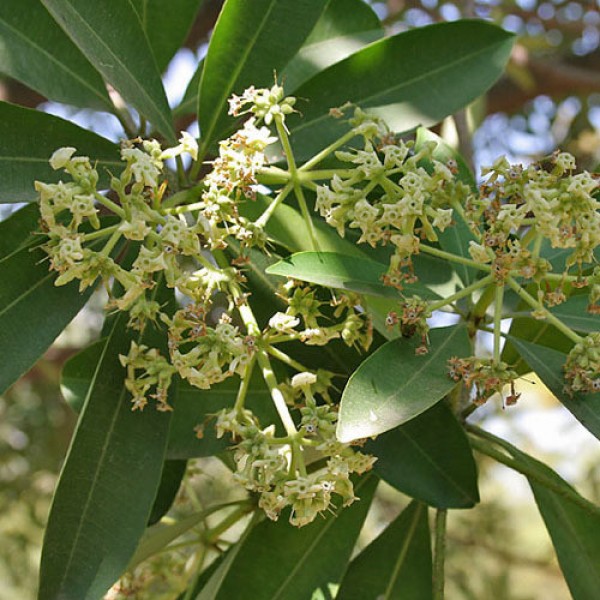This image is for reference purpose only, Photo May Slightly Different From Actual Item in Terms of Color Due to the Lighting During Photo Shooting or the Monitor's Display.
Alstonia Scolaris - Saptaparni
FAMILY: Apocynaceae (Dogbane Family)
GENUS: Alstonia
SPECIES: Scholaris
COMMON NAMES: Chatian (Hindi), Chhatim (Bengali), Dita (Tagalong), Dita Tree, Maddale (Kannada), Milky Pine, Pala, Saptaparna (Sanskrit, ‘seven-leaved’), Satvin, Shaitan (Arabic, ‘devil’), Yaksippala
Alstonia scholaris, commonly known as the dita tree, is an evergreen that may grow up to 100 feet tall. It has rough, grey bark and large leaves that grow in clusters of seven. The flowers are small and greenish-yellow in color. The fruits are thin pods that can grow up to 20 inches long. The sap of the tree is sticky and bitter (Ratsch 1998, 48).
The Alstonia scholaris plant is from India, and may now be found throughout Southeast Asia and Australia. The most successful method of propagation is through transplanting young trees, but seeds may also be used (Ratsch 1998, 48).
TRADITIONAL USES: Since ancient times, the Alstonia scholars tree has been used to make paper in India and other parts of South Asia. The wood has also been made in to writing tablets (Miller 1985). These things help to explain the name of the species, scholaris, and show the strong connection that this plant has with written language and scholarship. In India, many tribal peoples believe that the dita tree is evil and avoid it completely. They say that the tree is inhabited by an evil spirit who will possess any individual who dares walk or sleep beneath it. This spirit is also said to kill any individual who chooses to sleep beneath its branches. Thanks to this belief, dita trees have been spared much of the destruction that has faced other species of tree in India.
Richard Alan Miller states that the seeds of the dita tree were used in Tantric sexual rituals in order to assist males in prolonging erection and delaying orgasm. However, little more information on this topic is available. Tantric practitioners often write magical mantras on pieces of dita tree bark and wear them as amulets (Miller 1985).
In Australia, Aboriginal peoples use the latex of the dita tree to attach ceremonial raiments to the skin for rituals. However, it is unclear whether they are aware of any psychoactive properties of the plant, or whether they utilize them (Pearson 1992 cited in Ratsch 1998, 49). It is possible that small quantities of active alkaloids are absorbed through the skin after a period of prolonged contact, leading to mild psychoactive effects during the ceremonial experience.
TRADITIONAL PREPARATION: The seeds are the most potently psychoactive part of the dita tree, although many parts of the plant are medicinal. To prepare the seeds, 2 grams may be crushed and soaked in water overnight. The next day, the seed matter is filtered out and the liquid is consumed. To make a stronger brew, the seeds are soaked in boiling water. In order to appreciate the aphrodisiac properties of the plant, a dosage of 3 grams of seeds is good to start with. If this does not prove effective, the dosage may slowly be increased until the desired effects are achieved. Dosages may vary widely from individual to individual, so it is always best to start low and work up (Miller 1985).
MEDICINAL USE: The bark of the dita tree is used in Ayurvedic medicine to treat fever, malaria, troubles in digestion, tumors, ulcers, asthma, and so forth. The leaves and the latex are applied externally to treat tumors. The bark and roots are boiled with rice and eaten by girls daily for several weeks to treat excessive vaginal discharge. In Traditional Chinese Medicine, the dried leaves of the dita tree are used as an expectorant. Members of the Alstonia genus are used around the world to treat malaria (Voogelbreinder 2009, 77).
TRADITIONAL EFFECTS: The seeds of the dita tree contain indole alkaloids, which are known to be psychoactive. The bark also contains several alkaloids, including ditamine and echitamine. The Malaysian species A. angustifolia is also known to contain yohimbine, a well known aphrodisiac. The bark of the dita tree is said to have pronounced aphrodisiac effects. One of the indole alkaloids contained in the seeds, known as alstovenine, is also an MAO inhibitor, which allows for the psychoactive effects of the seeds when taken orally. Dita tree seeds are said to help men to maintain an erection and to delay orgasm during intercourse (Miller 1985). The alkaloid echitamine, found in the bark, is said to kill malaria, although it is significantly less effective than quinine in this matter, and this property has never been demonstrated in Western style medical studies.
Saptaparni (Alstonia Scolaris) Plant
- Live Saptaparni Plant along with plastic pot
- plants height with pot is 1 feet and pot size is 5 icnhes diameter.
- plants nature is outdoor, grows like tree, less watering
- Grows upto 30 to 60 feet, flowering tree
- Best tree variety, easy maintenance, fast growing
